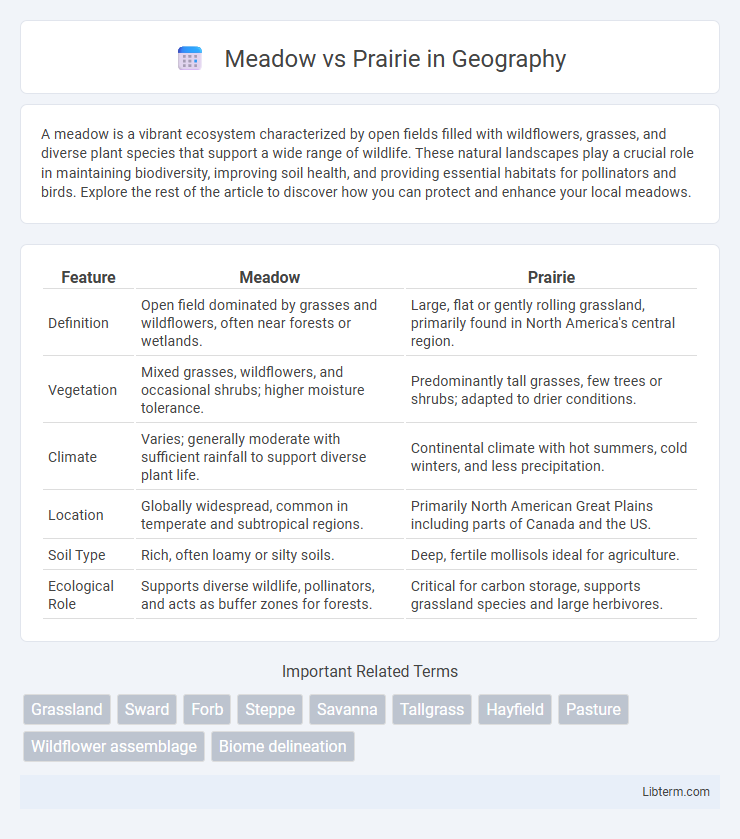A meadow is a vibrant ecosystem characterized by open fields filled with wildflowers, grasses, and diverse plant species that support a wide range of wildlife. These natural landscapes play a crucial role in maintaining biodiversity, improving soil health, and providing essential habitats for pollinators and birds. Explore the rest of the article to discover how you can protect and enhance your local meadows.
Table of Comparison
| Feature | Meadow | Prairie |
|---|---|---|
| Definition | Open field dominated by grasses and wildflowers, often near forests or wetlands. | Large, flat or gently rolling grassland, primarily found in North America's central region. |
| Vegetation | Mixed grasses, wildflowers, and occasional shrubs; higher moisture tolerance. | Predominantly tall grasses, few trees or shrubs; adapted to drier conditions. |
| Climate | Varies; generally moderate with sufficient rainfall to support diverse plant life. | Continental climate with hot summers, cold winters, and less precipitation. |
| Location | Globally widespread, common in temperate and subtropical regions. | Primarily North American Great Plains including parts of Canada and the US. |
| Soil Type | Rich, often loamy or silty soils. | Deep, fertile mollisols ideal for agriculture. |
| Ecological Role | Supports diverse wildlife, pollinators, and acts as buffer zones for forests. | Critical for carbon storage, supports grassland species and large herbivores. |
Defining Meadows and Prairies
Meadows are open habitats dominated by a diverse mix of grasses, wildflowers, and herbaceous plants, typically found in temperate regions with adequate moisture. Prairies, a specific type of grassland, are characterized by tallgrass species and deep root systems, primarily located in North America's central plains. Both ecosystems support rich biodiversity but differ in plant composition, soil type, and climate adaptation.
Key Ecological Differences
Meadows typically feature a diverse mix of grasses, wildflowers, and herbaceous plants thriving in moist, well-drained soils, while prairies are dominated by tallgrass or mixed grass species adapted to drier conditions and periodic fires. Meadows support higher biodiversity due to their varied plant structures providing habitats for a wide range of pollinators and small mammals, whereas prairies maintain soil health and carbon sequestration through deep-rooted grasses and extensive root networks. The ecological processes in prairies, like fire regimes and grazing patterns, are crucial for preventing woody plant encroachment, contrasting with meadows that rely more on seasonal water availability and less frequent disturbances.
Dominant Plant Species
Meadows are dominated by a diverse mix of grasses, wildflowers, and herbaceous plants such as bluejoint grass, coneflowers, and black-eyed susans. Prairies feature tallgrass species like big bluestem, switchgrass, and Indian grass, with a higher prevalence of native grasses than wildflowers. The dominant plant species in prairies contribute to their dense root systems essential for soil health, while meadows often support a wider floral variety catering to pollinators.
Wildlife and Biodiversity
Meadows support a diverse range of wildlife, including pollinators like bees and butterflies, small mammals, and ground-nesting birds, thriving in the varied wildflowers and grasses. Prairies boast higher biodiversity with deep-rooted native grasses and a complex ecosystem that sustains large herbivores such as bison, numerous bird species, and insects crucial to soil health. Both habitats play vital roles in maintaining ecological balance and supporting species adapted to open, grassy environments.
Climate and Geographic Distribution
Meadows typically thrive in temperate climates with moderate rainfall and are commonly found in regions such as North America, Europe, and parts of Asia, often near rivers or mountainous areas. Prairies are predominantly located in North America's central plains, characterized by continental climates with hot summers, cold winters, and moderate to low precipitation. The differing climatic conditions influence vegetation density and species diversity, with meadows supporting a mixture of grasses and wildflowers adapted to moist soils, while prairies consist mainly of hardy grasses suited to drier, more variable weather.
Soil Composition and Moisture Levels
Meadows typically have richer, loamy soils with higher organic content, supporting diverse plant species adapted to moderate moisture levels. Prairies generally feature deeper, well-drained soils with a sandy or silty texture that retains less moisture but supports drought-tolerant grasses and herbaceous plants. Soil composition in prairies promotes greater root penetration, aiding moisture absorption during sporadic rainfall compared to the more uniformly moist meadow soils.
Human Impact and Conservation
Meadows and prairies face significant human impact through urbanization, agriculture, and land development, leading to habitat fragmentation and biodiversity loss. Conservation efforts prioritize restoring native plant species, implementing sustainable land management practices, and protecting these ecosystems through reserves and ecological corridors. Enhancing public awareness and supporting policies for habitat preservation are critical to sustaining meadow and prairie biodiversity.
Seasonal Changes and Bloom Cycles
Meadows typically experience a rapid bloom cycle in spring and early summer, with wildflowers and grasses peaking in vibrant color before fading by late summer. Prairies display longer seasonal variation, often showcasing a diverse range of native grasses and forbs that bloom sequentially from spring through fall, supporting extended habitat function. Seasonal changes in meadows are more abrupt, while prairies endure gradual transitions that sustain continuous ecological productivity.
Restoration and Management Practices
Meadow restoration emphasizes planting native perennial grasses and wildflowers to enhance biodiversity, often involving controlled burns and seasonal mowing to prevent woody plant encroachment. Prairie management prioritizes maintaining historically fire-dependent ecosystems by implementing prescribed burns and rotational grazing to sustain native grass dominance and soil health. Both ecosystems require careful invasive species control and adaptive management strategies tailored to local climate and soil conditions.
Cultural and Historical Significance
Meadows have historically served as vital grazing lands in European agriculture, symbolizing rural traditions and seasonal cycles, while prairies hold deep cultural significance for Indigenous peoples of North America as sacred grounds linked to ancestral heritage and survival. Meadows often appear in European folklore and art, representing pastoral peace, whereas prairies embody vastness and resilience, central to Native American spiritual practices and community life. The preservation of both ecosystems reflects an ongoing respect for cultural identity and historical land use patterns across different continents.
Meadow Infographic

 libterm.com
libterm.com